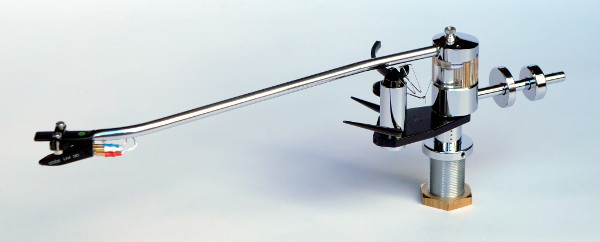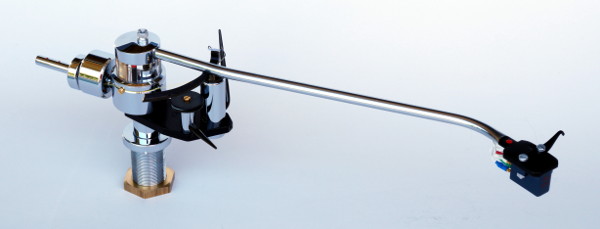

In spite of the slender appearance, the MØRCH tonearms have an amazing mechanical strength and stability. They are the result of the best precision mechanics, the finest craftsmanship, and realize technical and tonal claims without compromise.
What has been achieved with the MØRCH tonearms enables the cartridge to accomplish its task with extraordinary motional ease while maintaining a very high degree of stability.
The proof of their superiority lies in the listening! The MØRCH arm have received high acclaim from both critics and sceptics, simply because their sonic superiority can be easily demonstrated.


Above is model UP-4 with NARROW 9" armtube. Below is model DP-6 with PRECISION 9" armtube.
The fundamental tonearm resonance (present in all arms) is partly determined by the compliance and the weight of the cartridge that is to be used and partly by the weight of the arm, known as the “effective mass”. However, the frequency of the fundamental resonance can be moved up or down by altering the mass of the tonearm. Thus, by choosing the correct armtube out of 3 available, the fundamental resonance can be moved to a frequency where it does not interfere with the audio signal.


Typical DP-8 lateral resonance. Be aware that at very low frequencies where the modulation is horizontal, there is no fundamental resonance.
The amplitude just rolls off downwards. The graph was taken from this document, which contains more DP-8 examples
With the lightest of the armtubes you achieve the lowest effective mass, and with this particular armtube the MØRCH tonearm is the lightest available today. This armtube is designed for cartridges using a low tracking force, since they have a high compliance. For cartridges requiring a high tracking force (usually low compliant) one of the heavy armtubes should be chosen. Users that own more than one cartridge can mount each of them in its proper armtube. Changing cartridges then becomes a simple swap between armtubes. Thus the mass of the arm is always optimized for its cartridge.
A cavity in the central body housing the bearings is off-centered in the forward direction, providing an asymmetric mass distribution for the prevention of symmetrical barrel resonances. Both the rod with its balancing weights and the armtube are rigidly attached to the arm’s central body. The body itself is solid and very heavy. Thus vibrations originating in the cartridge are efficiently damped before they reach the bearings, their stability being assured.
In addition three counterweights of different size, and one tracking force weight contribute to the ideal concentration of the arm’s mass close to the fulcrum. The lateral balance is adjusted by way of the counterweights, which are eccentrically positioned on the counterweights rod.
The bearing assembly in the above mentioned cavity is in height located as an extension of the horizontal plane of the record surface. Therefore with warped records the motion of the stylus will remain vertical when bumps” are negotiated and warp wow will not be heard.
The antiskating force is applied by a watch spring. Its tension is adjustable for maximum accuracy even while a record is playing. The tension is transferred via a nylon string which is attached to the outside wall of the arm’s central body. As the armtube moves over the record, the correct geometry between the spring/filament assembly and the central body’s rotation provide for the exact variation of skating compensation over the entire playing surface of a record.
The tonearm is adjustable for the vertical tracking angle as well as the azimuth.
A special version of the 9" armtube called PRECISION 9" is supplied with a wide cartridge mounting platform having the underside precision ground for perfect contact with especially wide cartridges.
Also 12" armtubes are available. They are available only with the narrow headshell such as the one on the NARROW 9" armtubes. PRECISION 9" armtubes and 12" armtubes are available only with red and blue color codes.